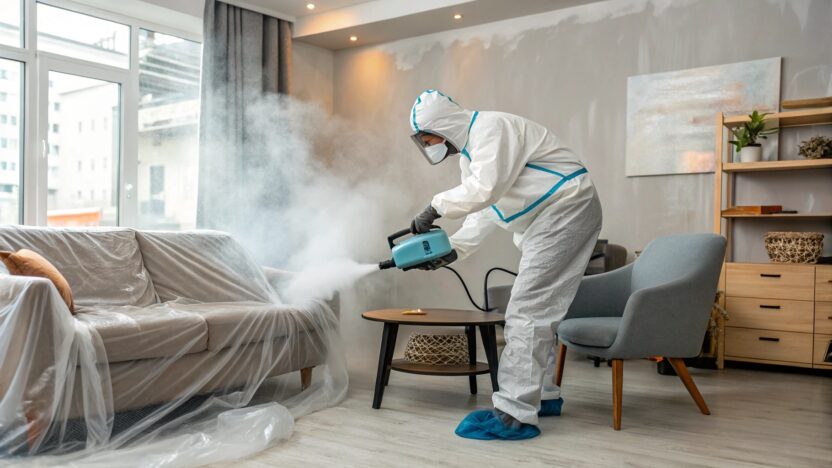Summary
After a fire, lingering smoke odor can be one of the toughest challenges for homeowners in Alexandria. This blog explains how professional fire restoration cleaners handle smoke odor removal using advanced techniques like thermal fogging, ozone treatment, and hydroxyl generators. From thorough inspections and surface cleaning to HVAC system deodorizing and structural sealing, discover the complete process that ensures your home is safe, clean, and odor-free after a fire.
_
Experiencing a fire in your Alexandria home can be incredibly stressful, not just because of the visible destruction, but also due to the stubborn smoke odor that can linger long after the flames are out. Even once debris is cleared and surfaces are cleaned, that lingering smell can stick around for weeks, even months, if not properly addressed.
In this post, we’ll walk you through how professional fire restoration teams in Alexandria handle smoke odor removal and what steps are involved to fully restore the air quality and comfort of your home.
Why Does Smoke Odor Linger?
Smoke odor tends to hang around because of tiny particles that settle into your home’s porous surfaces, things like drywall, upholstery, carpet, and even your ventilation system. These particles often contain strong-smelling compounds that continue to release odor, especially in humid or warm conditions.
The severity of the smell also depends on what burned. For instance, plastics, wood, and synthetic fabrics all produce different types of smoke. Some are oily and cling more aggressively to surfaces. For residents seeking effective smoke odor removal Alexandria services, it’s essential to work with specialists who use advanced deodorization techniques such as thermal fogging, ozone treatment, and hydroxyl generators.
How Professionals Remove Smoke Odor in Alexandria Homes
Here’s a step-by-step look at what to expect during a professional smoke odor removal process:
1. Property Inspection and Evaluation
The first step is a detailed inspection of the affected areas. Restoration specialists check:
- How far smoke and soot have spread
- Which materials are most affected
- What can be salvaged and what needs replacing
This evaluation helps create a plan tailored to your home’s unique needs.
2. Ventilation and Initial Air Cleaning
To start fresh, professionals ventilate the home and use air purification equipment such as:
- High-powered fans
- HEPA-filtered air scrubbers
- Negative air machines
This step removes airborne smoke particles and helps improve air circulation.
3. Deep Surface Cleaning
All exposed surfaces are cleaned using specially formulated products that neutralize smoke odors. This includes:
- Ceilings and walls
- Hard floors and carpets
- Fixtures, appliances, and furniture
In Alexandria’s historic homes, cleaners often use gentle, non-damaging solutions to protect delicate materials.
4. Disposing of Unsalvageable Materials
Some materials, like insulation, old carpets, or certain fabrics, can absorb smoke to the point where cleaning isn’t practical. These are removed to prevent recurring odors.
Items that can be saved may be taken to a restoration facility for deeper treatment.
5. Thermal Fogging
This process involves releasing deodorizing fog throughout the home. The fine mist reaches tight spaces and porous surfaces, neutralizing smoke particles where they hide.
It’s effective because it travels the same path smoke originally did, targeting hard-to-reach areas.
6. Ozone Treatment
Ozone generators are sometimes used to eliminate odor-causing molecules by oxidizing them. This method is highly effective but requires the home to be unoccupied during the process for safety reasons.
7. Hydroxyl Generator Use
For homeowners who need to stay in the house during restoration, hydroxyl generators are a safer alternative. These machines use UV light to break down odors and are safe for people, pets, and plants.
8. Cleaning the HVAC System
Since smoke can easily spread through your heating and cooling system, professionals will:
- Clean the ductwork
- Replace filters
- Deodorize the system internally
This ensures that smoke particles don’t continue to circulate through your home.
9. Sealing Structural Materials
In some cases, especially in older homes, smoke may have penetrated deep into structural elements like wooden beams or subfloors. If cleaning isn’t enough, professionals may apply odor-sealing primers or coatings to trap any remaining smell.
Final Thoughts
Smoke odor removal is not just about freshening the air; it’s about restoring your home to a safe, livable condition. That’s why it’s essential to work with trained fire restoration cleaners who use proven techniques and equipment to eliminate odors completely.
If your home in Alexandria has suffered fire damage, don’t wait. Reach out to a trusted local restoration team to bring your space and peace of mind back to life.



